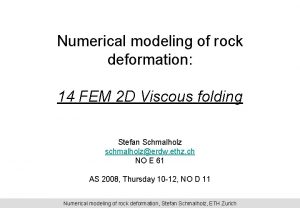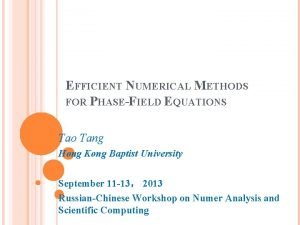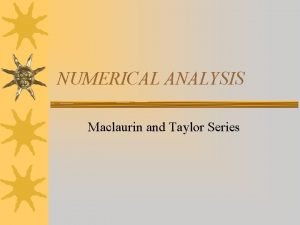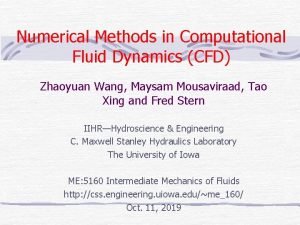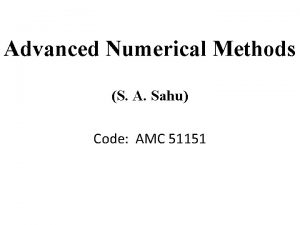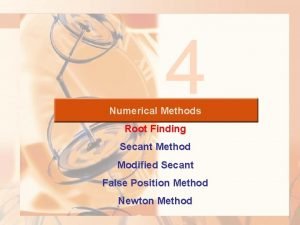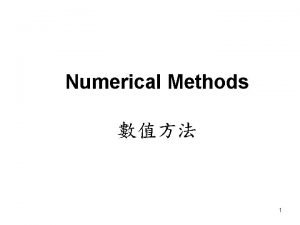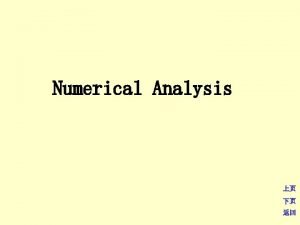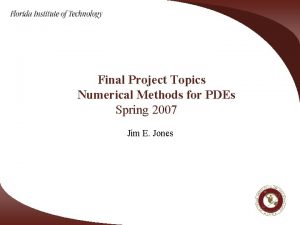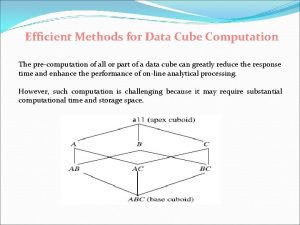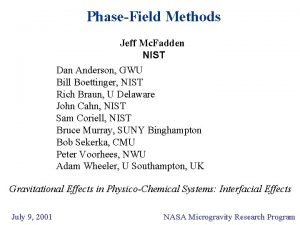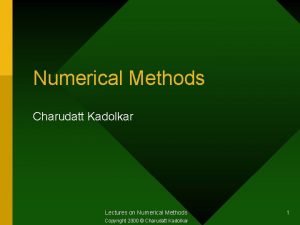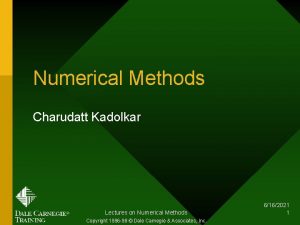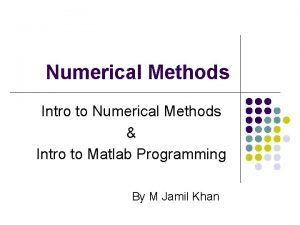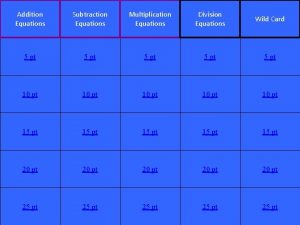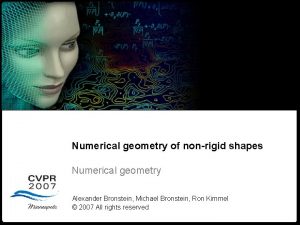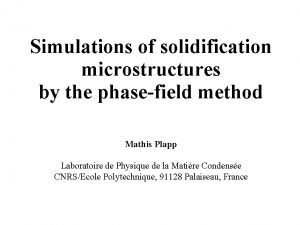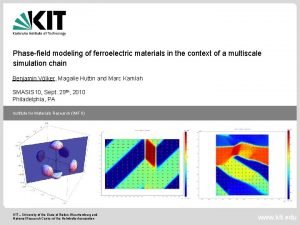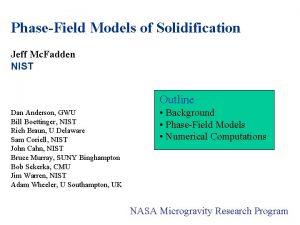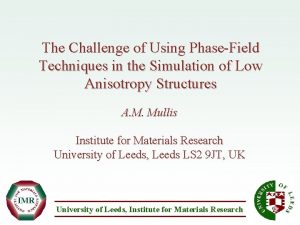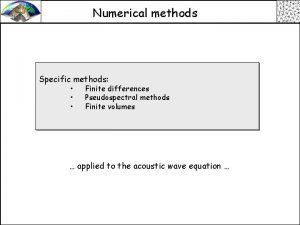EFFICIENT NUMERICAL METHODS FOR PHASEFIELD EQUATIONS Tao Tang







![EXAMPLE Cahn-Hilliard impainting [Bertozzi etc. IEEE Tran. Imag. Proc. 2007, Commun. Math. Sci, 2011] EXAMPLE Cahn-Hilliard impainting [Bertozzi etc. IEEE Tran. Imag. Proc. 2007, Commun. Math. Sci, 2011]](https://slidetodoc.com/presentation_image_h/30fdaa68596cc17199f06cfe07d2cf25/image-8.jpg)







![CONVERGENCE ANALYSIS [T. , H. -H. XIE, X. -B. YIN, JSC 2012] Theorem 1: CONVERGENCE ANALYSIS [T. , H. -H. XIE, X. -B. YIN, JSC 2012] Theorem 1:](https://slidetodoc.com/presentation_image_h/30fdaa68596cc17199f06cfe07d2cf25/image-16.jpg)
















![The initial condition is random in [-0. 1, 0. 1], with periodic boundary condition The initial condition is random in [-0. 1, 0. 1], with periodic boundary condition](https://slidetodoc.com/presentation_image_h/30fdaa68596cc17199f06cfe07d2cf25/image-33.jpg)

![EXAMPLE [ARTIFICIAL DISSIPPATION] MOLECULAR BEAN EPITAXY (MBE) MODEL: Model eqn: ht = - 2 EXAMPLE [ARTIFICIAL DISSIPPATION] MOLECULAR BEAN EPITAXY (MBE) MODEL: Model eqn: ht = - 2](https://slidetodoc.com/presentation_image_h/30fdaa68596cc17199f06cfe07d2cf25/image-35.jpg)




- Slides: 39

EFFICIENT NUMERICAL METHODS FOR PHASE-FIELD EQUATIONS Tao Tang Hong Kong Baptist University September 11 -13, 2013 Russian-Chinese Workshop on Numer Analysis and Scientific Computing

John W. Cahn (1928 -- ) John E. Hilliard (1826 -1987) The Cahn-Hilliard equation: describes the process of phase separation:

Microstructural evolution under the Cahn–Hilliard equation, demonstrating distinctive coarsening and phase separation.

PHYSICS Cahn-Hilliard equation Phase separation in a binary alloy (metal, liquid, …) Spinodal decomposition Mass conservation Interface minimization

MATHEMATICS

HIGH-ORDER NONLINEAR DIFFUSION EQUATIONS: How to do time integration? If both dynamics and steady state are required,how to do efficient time discretization? Higher order methods vs. efficiency; Adaptivity

EXAMPLES OF HIGH ORDER NONLINEAR DIFFUSION EQUATION Molecular Beam Epitaxy (MBE) Model [T. , Xu; WB Chen et ] Inpaiting with Cahn-Hilliard Equation [A. L. Bertozzi, etc] Phase field crystal equation [Lowengrub, Wang, Wise etc] Thin Film epitaxy [J. Shen, X. M. Wang, Wise, etc]
![EXAMPLE CahnHilliard impainting Bertozzi etc IEEE Tran Imag Proc 2007 Commun Math Sci 2011 EXAMPLE Cahn-Hilliard impainting [Bertozzi etc. IEEE Tran. Imag. Proc. 2007, Commun. Math. Sci, 2011]](https://slidetodoc.com/presentation_image_h/30fdaa68596cc17199f06cfe07d2cf25/image-8.jpg)
EXAMPLE Cahn-Hilliard impainting [Bertozzi etc. IEEE Tran. Imag. Proc. 2007, Commun. Math. Sci, 2011] Monotonic decrease of the energy functional during the coarsening process

NUMERICAL CHALLENGES Interior layers (i. e. thin interface) see a figure Time discretization: Lower order (good for stability)? “h”-adaptivity; “p”-adaptivity?

Thin-film epitaxy without slope selection Energy Cahn-Hilliard equation Energy Allen-Cahn equation Energy curves of three different models

EXAMPLE Consider the IBV problem for the Cahn-Hilliard Eq. Explicit Euler’s scheme (10 -7) Semi-implicit Euler’s scheme (10 -4) Implicit Euler’s scheme (10 -6)! Non-linearly stabilized scheme (implicit for the biharmonic and non-linear terms : -- 10 -3) Linearly stabilized splitting scheme: introducing two splitting functionals; one is contractive and the other is expansive: (10 -2 ~ 10 -3)

A STABLE FIRST-ORDER METHOD:

Eyre’s method Convexity splitting where and are strictly convex. The semiimplicit discretization is given by Various Eyre’s type or various extension: Inpaiting problem [Schönlieb & Bertozzi] Coarsening simulations [Vollmayr-Lee & Rutenberg] Second-order convex splitting [J. Shen, C. Wang, Wise] Question: Given Eyre’s GS scheme, can we use some iterative ideas to obtain a higher order semi-stable method?

SPECTRAL DEFERRED CORRECTION (SDC) FOR Y’=F(T, Y) The method is introduced by Dutt, Greengard and Rokhlin (BIT, 2000) Multi-implicit SDC method (Layton and Minion, 2004) SDC with high-order RK schemes [Christliek, Qiu and Ong, 2010] Collocation Method:

Algorithm (SDC method) 1 (Prediction). Use a k 0 -th order numerical method to compute 2 (Correction). For j=1, …, J l Compute the residual for l Define the error function for l Form the error equation l Use an k-th order method to compute at the grid points tn, i on [tn, tn+1]. l Define a new approximation solution
![CONVERGENCE ANALYSIS T H H XIE X B YIN JSC 2012 Theorem 1 CONVERGENCE ANALYSIS [T. , H. -H. XIE, X. -B. YIN, JSC 2012] Theorem 1:](https://slidetodoc.com/presentation_image_h/30fdaa68596cc17199f06cfe07d2cf25/image-16.jpg)
CONVERGENCE ANALYSIS [T. , H. -H. XIE, X. -B. YIN, JSC 2012] Theorem 1: Let be computed in the Correction step of the SDC Algorithm. If the step-size h is sufficiently small, then the following error estimate holds:

Outline Note

Algorithm (Modified SDC method) : Same as Algorithm 1, except that after is computed we use some Picard smoothing After the above k-1 iterations, let Theorem 2 Let be computed in the Correction step of the modified SDC Algorithm. If the step size h is sufficiently small, and if special collocation points (e. g. Gauss) are used, then

Proof. It follows from (S 1) that

Efficiency comparison using Legendre-Gauss quadrature nodes

Energy evolutions with different time steps

FIRST-ORDER LINEAR SCHEME Simple, linear discretization in time; First-order with energy decreasing; In space, central differencing FFT is used

STABILTY+ACCURACY VIA P-ADAPTIVITY Use Energy difference at and steps If the difference is small, no correction; If the difference is large, judge how many SDC corrections are needed. Note most of time regimes, no corrections are needed

fine sh e m coarse mesh with correction


Energy evolutions with different time steps and different numbers of corrections for the Cahn-Hilliard equation

Blowing up phenomenon of semi-implicit spectral deferred correction with uniform number of corrections

HOW MANY ITERATIONS NEEDED

Energy curves of the thin film model without slope selection and number of corrections CPU time comparison

ADAPTIVE TIME STEPPING: Energy is an important physical quantity to reflect the structure evolution. Adaptive time step is determined by ∆tmin corresponds to quick evolution of the solution, while ∆tmax to slow evolution. [Qiao, T. , Zhang, SISC, 2010]

TIME ADAPTIVITY VIA ENERGY VARIATION (XIE; T. , LUO) Numerical Scheme for C-H eqn: Stability: Discrete energy identity:

Equi-energy: • It follows from the numerical scheme and the energy identity that • The prescribed energy decrease ( ) equation • Time stepping formula • One step fix-point iteration to solve the prescribed energy decrease equation
![The initial condition is random in 0 1 0 1 with periodic boundary condition The initial condition is random in [-0. 1, 0. 1], with periodic boundary condition](https://slidetodoc.com/presentation_image_h/30fdaa68596cc17199f06cfe07d2cf25/image-33.jpg)
The initial condition is random in [-0. 1, 0. 1], with periodic boundary condition and

![EXAMPLE ARTIFICIAL DISSIPPATION MOLECULAR BEAN EPITAXY MBE MODEL Model eqn ht 2 EXAMPLE [ARTIFICIAL DISSIPPATION] MOLECULAR BEAN EPITAXY (MBE) MODEL: Model eqn: ht = - 2](https://slidetodoc.com/presentation_image_h/30fdaa68596cc17199f06cfe07d2cf25/image-35.jpg)
EXAMPLE [ARTIFICIAL DISSIPPATION] MOLECULAR BEAN EPITAXY (MBE) MODEL: Model eqn: ht = - 2 h - [ (1 - | h|2) h ] Energy identity: where

ARTIFICIAL DISSIPATION: Remedy: i. e. an O( t) is added, where A > 0 is an O(1) constant. Property: If the constant A is sufficiently large, then E(hn+1) E(hn)? If the numerical solution is convergent, then the condition for A is T & C. Xu: [SINUM, 2006]

MORE ON REGULARITY: Consider the nonlinear 2 -D model for epitaxial growth of thin films: Here, we prove an a-priori bound on the L -norm of h in the 2 -D case with =0. The proof heavily relies on the maximum principle. It is hard to see how it can be extended to the case of (small) positive . However, it is intuitively clear that in the case of positive , the solution should be more regular, and one may expect that the similar bound on h still holds.

CONCLUSIONS/REMARKS High-order time discretization is needed for high-order nonlinear diffusion equations. The use of the SDC method seems a useful way. Analysis of nonlinear stability and convergence require deep understanding of the relevant PDEs and numerical methods. [local estimates … T. & Xu SINUM 2006, Bertozzi etc] The analysis for adaptive schemes is highly nontrivial. Most of the existing numerical methods are lack of rigorous mathematical justification.

THANKS! HTTP: //WWW. MATH. HKBU. EDU. HK/~TTANG
 Song dynasty rulers
Song dynasty rulers Numerical methods for partial differential equations eth
Numerical methods for partial differential equations eth General solutions of differential equations
General solutions of differential equations Productively efficient vs allocatively efficient
Productively efficient vs allocatively efficient Productively efficient vs allocatively efficient
Productively efficient vs allocatively efficient Productively efficient vs allocatively efficient
Productively efficient vs allocatively efficient Productively efficient vs allocatively efficient
Productively efficient vs allocatively efficient Productively efficient vs allocatively efficient
Productively efficient vs allocatively efficient Tạng phủ con chính ngài đã cấu tạo
Tạng phủ con chính ngài đã cấu tạo Tao tang
Tao tang Graphical and numerical methods
Graphical and numerical methods Definition interpolation
Definition interpolation Taylor series numerical methods
Taylor series numerical methods Types of error in numerical methods
Types of error in numerical methods Backward euler method
Backward euler method Cfd numerical methods
Cfd numerical methods Numerical methods for describing data
Numerical methods for describing data Numerical methods of descriptive statistics
Numerical methods of descriptive statistics Gauss forward interpolation formula
Gauss forward interpolation formula Modified secant method example
Modified secant method example Fixed iteration method
Fixed iteration method Numerical methods
Numerical methods Error aleatorio formula
Error aleatorio formula Cubic hermite interpolation
Cubic hermite interpolation Pde project topics
Pde project topics Data cube computation
Data cube computation Era uma estrela tão alta era uma estrela tão fria
Era uma estrela tão alta era uma estrela tão fria Impluwensya ng hapon sa pilipinas
Impluwensya ng hapon sa pilipinas Paghambi
Paghambi Wax pattern fabrication pdf
Wax pattern fabrication pdf Choose the methods of solving quadratic equations
Choose the methods of solving quadratic equations Iso 22301 utbildning
Iso 22301 utbildning Typiska novell drag
Typiska novell drag Nationell inriktning för artificiell intelligens
Nationell inriktning för artificiell intelligens Returpilarna
Returpilarna Varför kallas perioden 1918-1939 för mellankrigstiden
Varför kallas perioden 1918-1939 för mellankrigstiden En lathund för arbete med kontinuitetshantering
En lathund för arbete med kontinuitetshantering Kassaregister ideell förening
Kassaregister ideell förening Tidbok yrkesförare
Tidbok yrkesförare A gastrica
A gastrica

